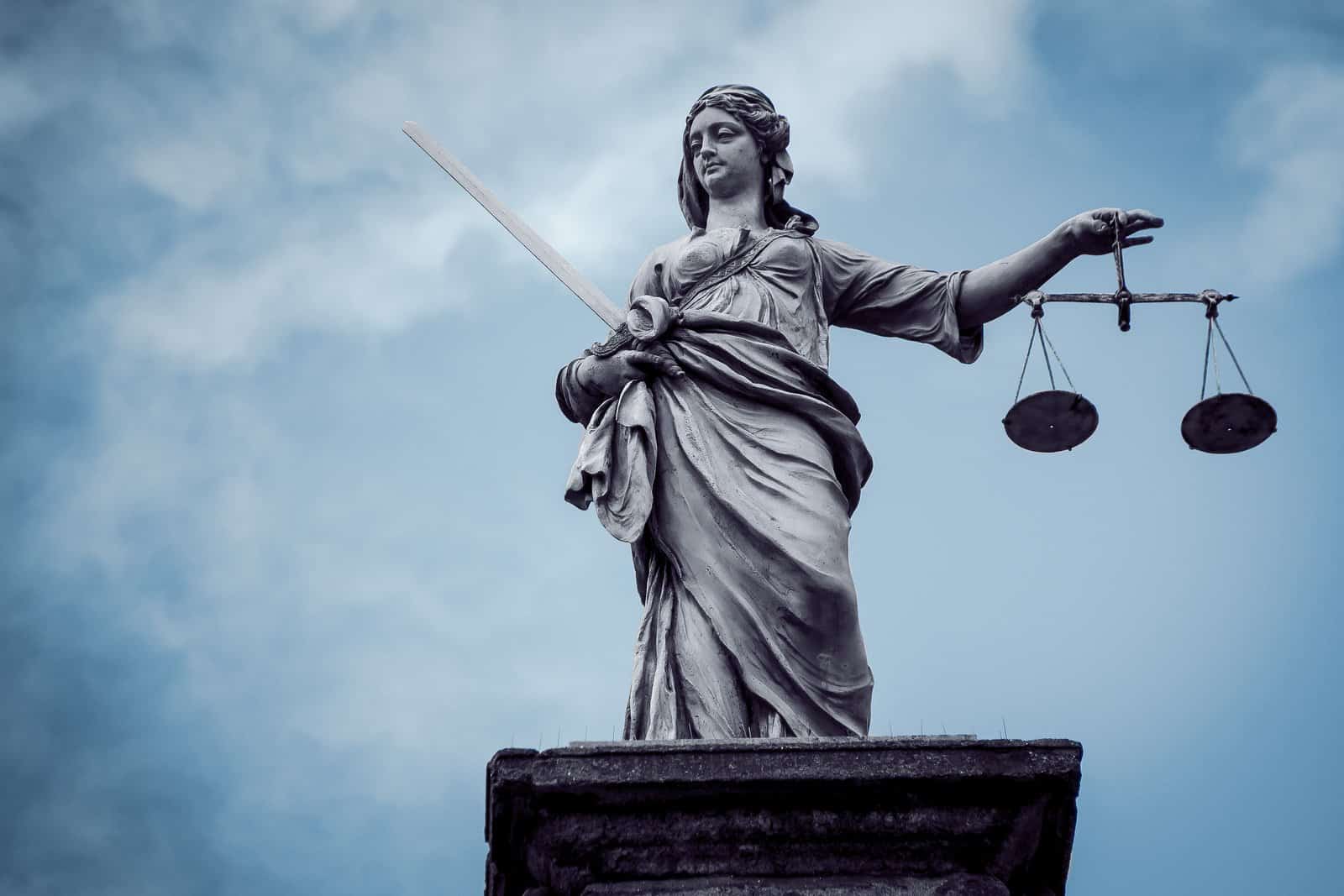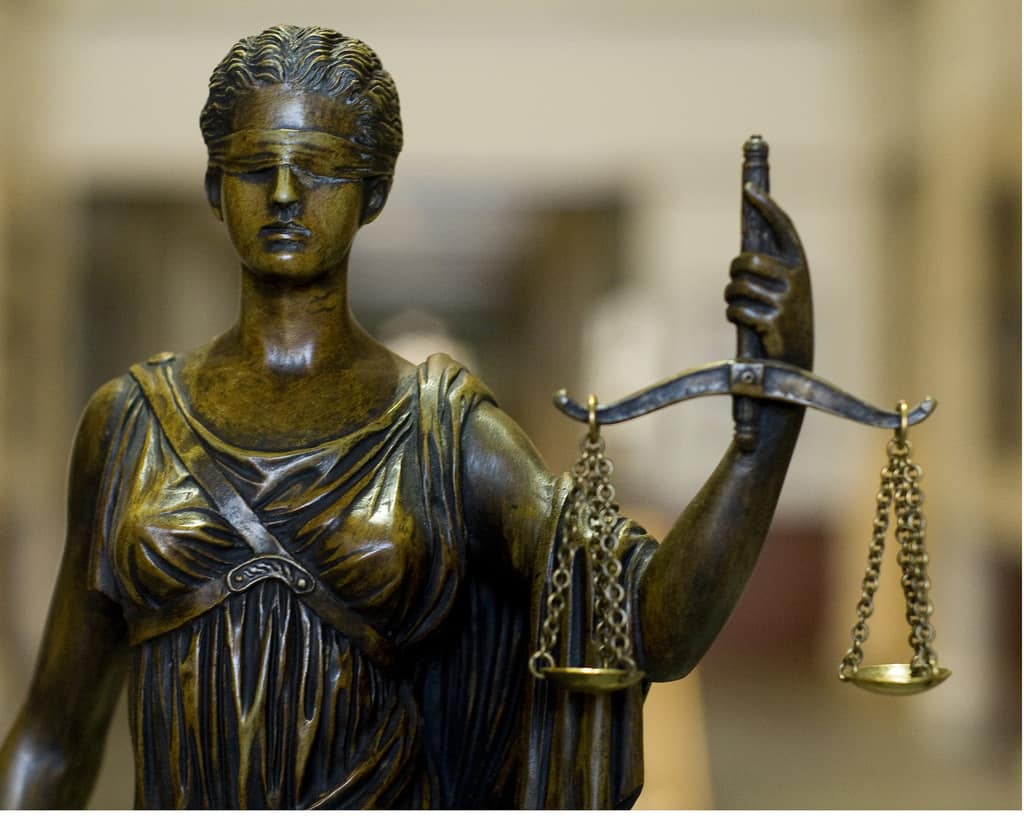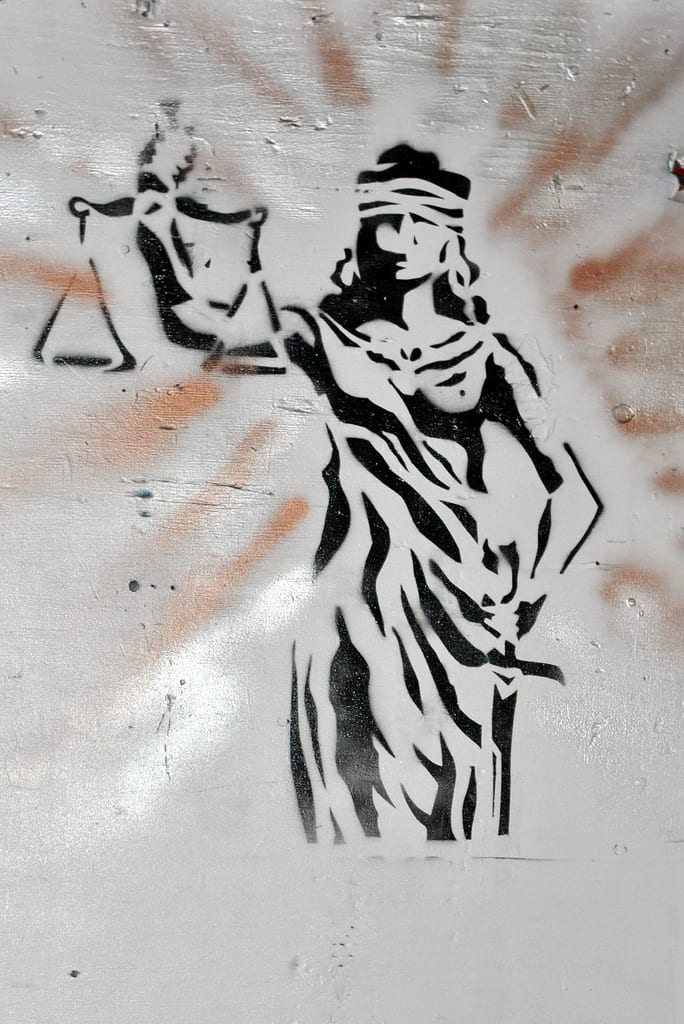Somewhere, somehow, we began talking of law as “Justice.” The government’s lawyers work at the Department of Justice. Law enforcement is part of the “criminal justice” system. We talk of courts “doing justice.” The Supreme Court speaks of “traditional notions of fair play and substantial justice” as the grounds for a court to even claim jurisdiction over a person.1 You’d think, then, that we know what we are talking about. Yet “justice” is one of those concepts entirely unclear, even to those of us who talk about it. Often, “justice” just becomes one of the many magic words lawyers and judges use. I wonder if we actually tried to work for justice, what would be the result?
***
Once upon a time, in a magical place sandwiched between lakes Mendota and Monona, a young lawyer (okay it was me… I was just trying to build the suspense a little!) had a pair of clients. First, there was the young high school girl arrested after getting into a fight with her mother, who called the police “to scare her.” 2 After my client spent a night in jail,3 her mother (i.e. the victim) decided that was enough and that she wouldn’t press charges. The district attorney smiled at this quaint notion. After all, the dignity of the sovereign state of Wisconsin had been offended and her peace breached; it was the State that would decide what charges to press, not her. The family faced an uncomfortable reality — they thought that their daughter had learned her lesson, and was ready to go on her way; the government of the State of Wisconsin, however, had not yet made up its mind and was ready and willing to inflict upon this young lady the full penalties of a criminal conviction. Thankfully, with a good amount of lawyering, references from peers, teachers, family members, and some counseling, the case was dismissed without trial.
The other client was a young man who liked to drive cars. Unfortunately, the owners of said cars often did not know he was driving them. This client was not yet 21 but had been in and out of jail and juvenile detention several times. On his latest case, he was sentenced to the local jail but given “Huber” privileges – commonly known as work release, he was allowed out several hours a day to go to his job.4 He called me one day, in tears, his voice trembling and much softer than I would have ever expected; he was scared of going back, terrified of what his life was becoming, unable to see how anything would be able to make his life better.
In both of these cases, we can be confident that “justice was done.” After all, in the end the young girl wasn’t prosecuted. She learned a lesson; justice was done. And my unfortunate driver client had been properly convicted of a criminal offense and was serving time; his anxiety and fear were just a result of his decisions. He was guitly and being punished; justice was done.
But was it? After both these cases – and too many others as well – I’d often find myself asking some version of this question: was justice really done? I was haunted by this question, by this idea. I still am.
It’s a problem, this justice question. One that emerges not just in criminal work, though it is very present there (if you are familiar with our broken immigration system, you might already be aware of how these kinds of questions arise in our legal system). Talk with judges in family courts, or guardians ad litem appointed to represent children and vulnerable adults in judicial proceedings; they can describe to you just how those groups are treated. Spend a day at intake courts, criminal or civil, struggling to give adequate attention to any case that comes before them; you’ll soon understand why they’re sometimes called cattle calls.5 In such circumstances, can we be confident that justice is being done?
***
This is not to say that courts are useless. They’re not. Courts are, for example, useful tools for resolving disputes. That is, basically, what a court does. In the grand scheme, courts “say what the law is.”6 On the everyday level, this means that they figure out who caused which car accident and who should pay. They tell divorcing parties who gets custody of the kids and who gets to keep the DVD collection.7 Judges, prosecutors, police and, if we’re lucky, defense attorneys, help figure out who to punish and when/how laws have been broken. The judicial system deals with liabilities and conflict resolution. We call this “justice” and we move on.
And maybe it is. Maybe this is the closest we can get. Or maybe not.
A few months ago, the New York Times Magazine had a fascinating article about something known as “restorative justice.” From the provocative title on, the article asks: “Can Forgiveness Play A Role in Criminal Justice?” Their attempt at an answer involves telling the story of a young man, Conor McBride, who was convicted of shooting and killing his longtime girlfriend, Ann Grosmaire. It’s a tragedy.
Ann and Conor had been dating for 3 years. In March of 2010, they got into a fight over what the Times called “mundane things many couples fight about.” Via phone call, text message, and in person, they fought for some 38 hours before the fight ended with a gunshot.
Conor seems to have immediately regretted his actions, turning himself in to the local police within an hour of the shooting. The really intriguing thing, though, is what happened next: Ann’s family tried to forgive him. After killing their daughter they tried to forgive Conor, her former boyfriend; her murderer. Ann’s father says he had an experience of Ann calling on him; asking her father to forgive:
Ann’s face was covered in bandages, and she was intubated and unconscious, but [her father] felt her say, “Forgive him.” His response was immediate. “No,” he said out loud. “No way. It’s impossible.” But [he] kept hearing his daughter’s voice: “Forgive him. Forgive him.”
It was in response to this appeal that Ann’s family began a process called “restorative justice”. The first steps involved bringing in an expert in the field named Sujatha Baliga, herself a lawyer and former public defender. Then the family began working with the local prosecutor to see whether he would be willing to entertain the process, before talking to Conor’s own family and, ultimately, with Conor himself. All of these steps culminated in a meeting with all of these interested parties. From the Times:
Baliga laid out the ground rules: [Prosecuting Attorney] Campbell would read the charges and summarize the police and sheriff’s reports; next [Ann’s parents] would speak; then Conor; then [his parents] … No one was to interrupt. Baliga showed a picture of Ann, sticking out her tongue as she looks at the camera. If her parents heard anything Ann wouldn’t like, they would hold up the picture to silence the offending party. Everyone seemed to feel the weight of what was happening. “You could feel her there,” Conor told me…
“It was excruciating to listen to them talk,” Campbell says. “To look at the photo there. I still see her. It was as traumatic as anything I’ve ever listened to in my life.”
Conor was no less affected. “Hearing the pain in their voices and what my actions had done really opened my eyes to what I’ve caused,” Conor told me later. “Then they were like, ‘All right, Conor, it’s on you.’ And I had to give an account of what I did.” He leaned forward, placed his elbows on his knees and looked directly at [Ann’s parents], who were seated opposite him. It was difficult to get started, but once he did the story came out of him in one long flow.
In the end, it was Campbell, the prosecutor, who made the final sentencing decision, but this process meant that everyone was involved. Originally, the prosecutor believed he could never offer a sentence of less than 40 years. Ultimately, the prosecutor offered Conor a choice: 20 years in prison plus 10 years of probation, or just 25 years in prison. He took the 20 years plus 10 of probation. Together the principal actors engaged a process to find what was best in this case. It was a process of justice.
Restorative justice is about more than a just process, it’s about restoration; bridging gulfs and making amends. It brings together offenders and victims and the broader community to do so. Restorative justice is different than the usual legal systems in that way. More people are brought together. People who normally are abstract considerations before judges and attorneys suddenly become real in this process. Traditional methods can leave them disenfranchised; restorative justice makes them part of the process. In short, it is about moving beyond punishment to rehabilitation, to restoration of the peace and dignity of a shattered community.
***
And, let’s be honest, the legal system is not set up to encourage forgiveness and reconciliation. Reading about Conor and Ann and the process of a just forgiveness, the Jesuit in me was consoled by the example of reconciliation and healing. The defense lawyer in me, though, was in full-on panic mode. Sit my client down in a room and have him basically confess? No motions, no trial, no jury? Trusting the same prosecutor whose job it is to put my guy in jail? Thanks, but I’ll pass. Even the idea of giving victims a voice is a bit uncomfortable for the defense lawyer in me. The reason most victims feel shut out of the process, after all, is because lawyers don’t want them there. They bring an emotional response out of everyone, and usually us lawyers tend to avoid that. Victims put a name, a face, a story to the crime; that is, they tell a story in which the defendant is the bad guy.8
It’s not just defense attorney’s who hesitate, even for prosecutors the inclusion of victims can be problematic. They may have a deal worked that will resolve the case. Victims might object. Objections might scuttle the deal before the judge. Or, worse, it might bring pressure on the prosecutor’s office to “get tough” on criminals.9 Getting tough sounds good, but it usually ends up with fewer deals and more trials, that is, more expense and more time spent on each case.
Broadly speaking, the legal system rarely prioritizes forgiveness and reconciliation. Lawyers are obligated first and foremost to be zealous advocates for their clients.10 We are allowed to bring moral and ethical considerations to our client’s attention,11 but it is the client who directs the ends of the litigation.12 The system is set up as an adversarial process. It is that process lawyers are trained to rely upon to produce the “just” result.13 And suffice it to say that being adversaries does not make it easy to be partners in reconciliation.
The question emerges, then, is a process of restorative justice better than what we have? Ought we to focus on questions of forgiveness and reconciliation? Answer such questions come down to what we think the legal system is for. Our current system is good at… resolving conflicts. Bad guys get sent to jail. Divorced couples have property divided. Liability is allocated for accidents.
There are problems, though. Conflicts are resolved through bald assertions of power. Judges and lawyers apply rules that they know and others don’t. Magic words and arcane invocations begin a process that ends with someone in jail, or a parent denied custody. Even highly charged cases with grand implications for how we work in society can get hung up on technicalities.14 What happens in these instances is that people who are directly affected by the cases are left powerless. Hired professionals do everything for them. Their lives are dictated by professionals operating within unfamiliar, sometimes incomprehensible, norms.
So, what we have is an adversarial system relying upon specialists who exercise esoteric power on behalf of others. One that keeps those most affected by the process on the margins. One in which reconciliation and forgiveness is mostly an afterthought. These are the concerns of our justice system. In today’s America, this is what happens when justice is done.
***
This is not to say that restorative justice is completely ignored in our legal system. The McBride case is a powerful image of how restorative justice is making inroads even in the highly-charged atmosphere of violent crimes. Across the country, other restorative justice programs are working with criminal offenders in specialized drug courts – some of which deal explicitly with juvenile and family issues. The goal of these is to help break cycles that lead to criminal behavior.
We can, and should, expand these programs. Not that doing so will be easy. These programs are costly and make legal processes longer and often more complex. More importantly, they challenge and even upend the vision of justice to which we have grown accustomed. Currently lawyers and judges are trained in ways that make us suspicious of restorative justice initiatives. Injured parties may be suspicious, wanting to make sure they are properly compensated, or that the one who injured them is punished. In our current system we’ve grown used to the kind of justice that theoretically discourages bad behavior, that frightens the young and punishes continued lawlessness with increasingly severe penalties. We’re used to doing this and saying: “Justice was done.” But now we’ve got lingering questions. The adversarial process might not be the best model.
What will be needed is more than new processes and structures, but an incentive structure that encourages parties to begin the process of reconciliation.15 In short, we need to make our legal processes part of the processes of reconciliation, not parallels or counterparts to them. Then, we can speak of a justice system that is truly just.
— — // — —
- See, e.g., International Shoe Co. v. Washington, 326 U.S. 310, 320 (1945). This is one of those rare cases that allow lawyers to sound both lawyerly and absurd at the same time, as in, “Well, as International Shoe says regarding long-arm statututes…”. Maybe you had to have been there… ↩
- Note to parents everywhere, this is will never, ever end well. There might be times when police intervention is needed in a family. “To scare my kid” is totally not one of them. The best that happens is your child has an arrest record. The worst involves such minor inconveniences as felony convictions, prison time, and an, ahem, “derailed” career path. ↩
- Though she was in high school, she was old enough to face criminal, not juvenile, prosecution. Wisconsin mandates criminal prosecution for all those having reached their 17th birthday. Wis. Stat. § 938.02(1). ↩
- Wisconsin’s “Huber Law” is found at Wis. Stat. § 303.08 ↩
- Wisconsin alone dealt with over 980,000 cases in 2012. The Wisconsin Courts website has this handy 1-page breakdown, http://www.wicourts.gov/publications/statistics/circuit/docs/caseloadstate12.pdf. If you want to see more statistics, their current publications can be found at http://www.wicourts.gov/publications/statistics/index.htm ↩
- Marbury v. Madison, 5 U.S. (1 Cranch) 137, 177 (1803). ↩
- Yeah, really. I had a case once where my client and the soon-to-be-ex spent more dough paying the lawyer to argue over a DVD collection than the DVDs were worth. ↩
- The defense attorney in me initially wrote this piece with only last names, but my editor kept changing it to first names. He wanted you — the audience — to have a connection to the people we are talking about. The attorney? Well, I’d rather you not get too friendly with the people who want to put the defendant in jail. ↩
- The article notes how a prosecutor might face the risk of appearing “soft on crime” by choosing to do a restorative justice program (in this case run by a woman from California even!) that gave a reduced sentence to a murderer. Such incentives can be constant throughout the legal system. ↩
- See, e.g., Model Rules of Professional conduct (MRPC), Preamble & Scope. The MRPC is available on the American Bar Association’s website at: http://www.americanbar.org/groups/professional_responsibility/publications/model_rules_of_professional_conduct/model_rules_of_professional_conduct_table_of_contents.html and is the basis for most state rules governing the conduct of lawyers. ↩
- MRPC, Rule 2.1 ↩
- MRPC Rule 1.2(a). ↩
- “The benchmark for judging any claim of ineffectiveness must be whether counsel’s conduct so undermined the proper functioning of the adversarial process that the trial cannot be relied on as having produced a just result.” Strickland v. Washington, 466 U.S. 668, 686 (1984). ↩
- An example: Back in 2004, the Supreme Court was faced with a question of whether the Pledge of Allegiance was unconstitutional; the case was resolved on fairly mundane questions of standing – that is, did the plaintiff actually have the right to go to court. The deeper questions about the role of religion in American life raised by the parties were left unresolved. See, Elk Grove Unified School District v. Newdow, 542 U.S. 1 (2004). ↩
- For example, in child custody cases, Wisconsin judges are allowed to deny custody to a parent who demonstrates that he or she unreasonably refuses to work with the other parent to make decisions in the best interest of the child. Wis. Stat. § 767.41(2)(c). ↩





